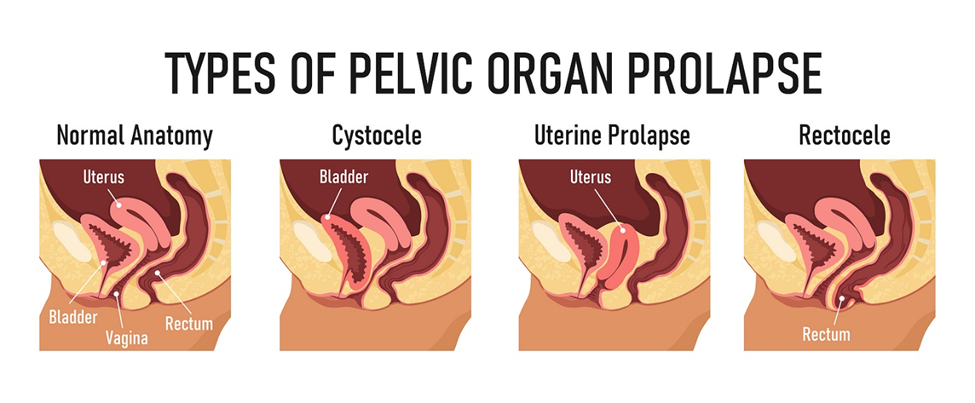A nurse is reading a journal article about care of the woman with pelvic organ prolapse. The nurse would expect to find information related to which disorder? (Select All that Apply.)
rectocele
fecal incontinence
urinary incontinence
cystocele
enterocele
Correct Answer : A,D,E
A. Rectocele:
A rectocele is a type of pelvic organ prolapse where the rectum bulges into the back wall of the vagina. Management and care of women with rectocele are relevant to the topic of pelvic organ prolapse.
B. Fecal incontinence:
Fecal incontinence refers to the inability to control bowel movements, which is not a typical symptom or complication of pelvic organ prolapse. While pelvic floor dysfunction can contribute to fecal incontinence, it is not the primary focus of care for women with pelvic organ prolapse.
C. Urinary incontinence:
Urinary incontinence, particularly stress urinary incontinence, can coexist with pelvic organ prolapse due to pelvic floor muscle weakness. However, urinary incontinence is a separate condition that may require different management approaches compared to pelvic organ prolapse. While relevant in the context of pelvic floor dysfunction, urinary incontinence is not specific to the care of women with pelvic organ prolapse.
D. Cystocele:
A cystocele is a type of pelvic organ prolapse where the bladder protrudes into the front wall of the vagina. Management and care of women with cystocele are also pertinent to the topic of pelvic organ prolapse.
E. Enterocele:
An enterocele is a type of pelvic organ prolapse where the small intestine bulges into the upper vaginal wall. Information about the care of women with enterocele would be expected in a journal article about pelvic organ prolapse.

Nursing Test Bank
Naxlex Comprehensive Predictor Exams
Related Questions
Correct Answer is D
Explanation
A. Blood transfusion:
Historically, blood transfusions were a significant mode of HIV transmission. However, with improved screening techniques and blood supply management, the risk of HIV transmission through blood transfusions has been greatly reduced. It's still a potential risk, but much less common than it used to be.
B. Sharing needles for IV drug use:
Sharing needles or other drug paraphernalia is a high-risk behavior for HIV transmission because it can directly introduce infected blood into the bloodstream. Injection drug use is a significant risk factor for acquiring HIV, especially among adolescents and adults who engage in this behavior.
C. Perinatal transmission:
Perinatal transmission occurs when a pregnant woman with HIV passes the virus to her child during pregnancy, childbirth, or breastfeeding. With proper medical care and interventions, the risk of perinatal transmission can be significantly reduced. However, without appropriate interventions, the risk of transmission from mother to child is significant.
D. Sexual intercourse:
Sexual intercourse, particularly unprotected vaginal, anal, or oral sex with an infected partner, is the most common mode of HIV transmission among adolescents and adults. It's important to educate individuals about safe sex practices, including the use of condoms and communication with sexual partners about HIV status, to prevent transmission.
Correct Answer is C
Explanation
A. Attach a sign above her bed to have BP, IV lines, and lab work in her right arm.
- This option is not appropriate because after a right-sided modified-radical mastectomy, it's generally contraindicated to use the affected arm (right arm in this case) for blood pressure measurements, IV lines, or blood draws. This is because such procedures can impede lymphatic drainage and increase the risk of lymphedema. Therefore, the unaffected arm is typically preferred for these purposes to reduce the risk of complications.
B. Encourage her to turn, cough, and deep breathe at frequent intervals.
- While turning, coughing, and deep breathing are essential postoperative nursing interventions to prevent respiratory complications such as pneumonia, they are not specific to the unique needs of a woman who has undergone a mastectomy. These interventions are more focused on general postoperative care rather than addressing the specific concerns related to mastectomy, such as lymphedema management.
C. Position her right arm below heart level.
- This is the correct choice. Positioning the right arm below heart level helps reduce swelling and promotes lymphatic drainage, particularly after surgery involving the lymph nodes, as in a mastectomy. This positioning aids in preventing complications such as lymphedema and supports optimal circulation and fluid balance in the affected arm.
D. Ask the client how she feels about having her breast removed.
- While emotional support and addressing the client's feelings are important aspects of care for a woman who has undergone a mastectomy, this intervention is more appropriate during psychosocial assessment and counseling sessions, rather than immediately postoperatively. At this stage, the focus should be primarily on physical recovery and addressing immediate postoperative needs, such as pain management and prevention of complications like lymphedema. Emotional support can certainly be provided, but it should not be the primary intervention immediately following surgery.
Whether you are a student looking to ace your exams or a practicing nurse seeking to enhance your expertise , our nursing education contents will empower you with the confidence and competence to make a difference in the lives of patients and become a respected leader in the healthcare field.
Visit Naxlex, invest in your future and unlock endless possibilities with our unparalleled nursing education contents today
Report Wrong Answer on the Current Question
Do you disagree with the answer? If yes, what is your expected answer? Explain.
Kindly be descriptive with the issue you are facing.
